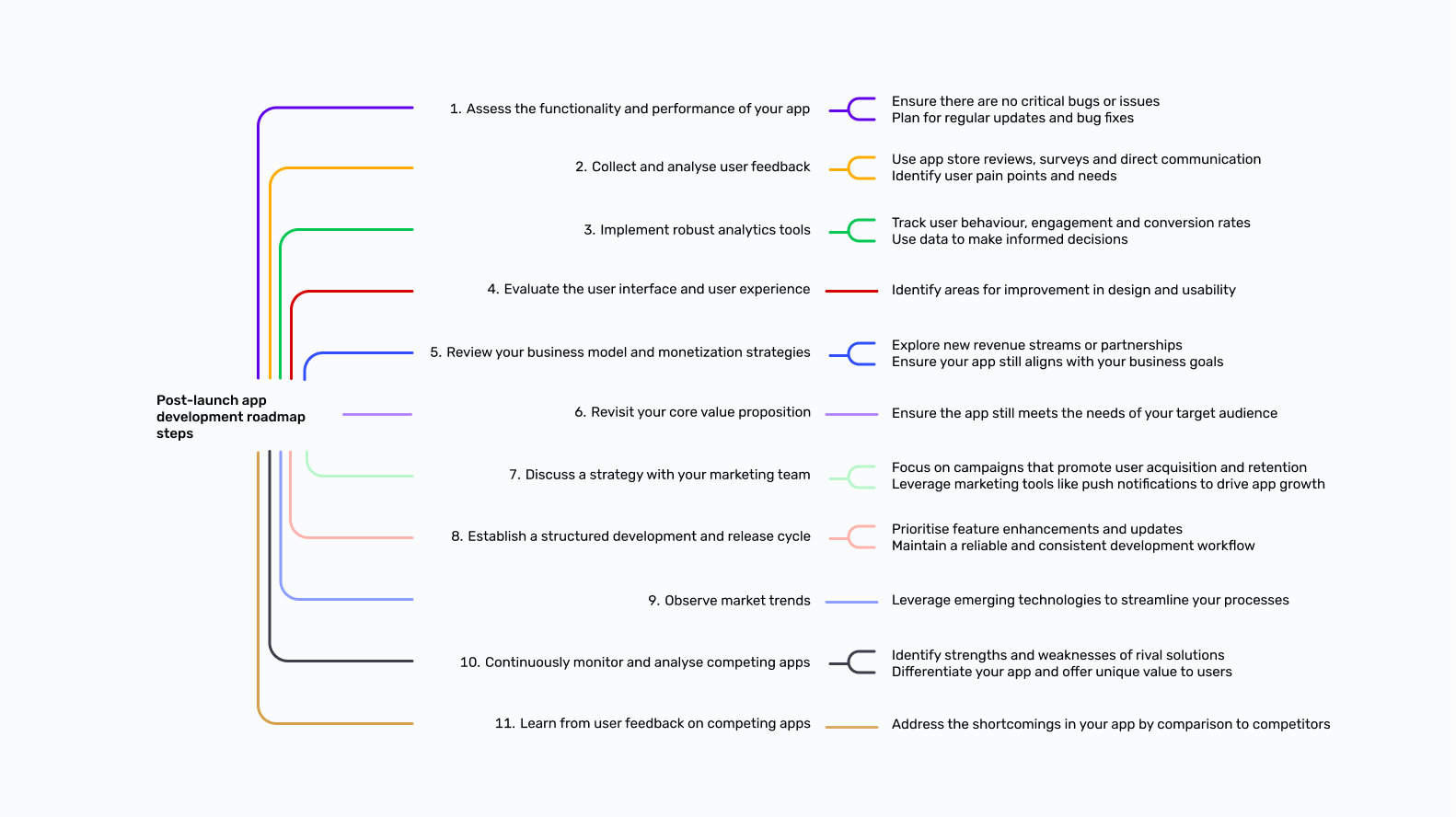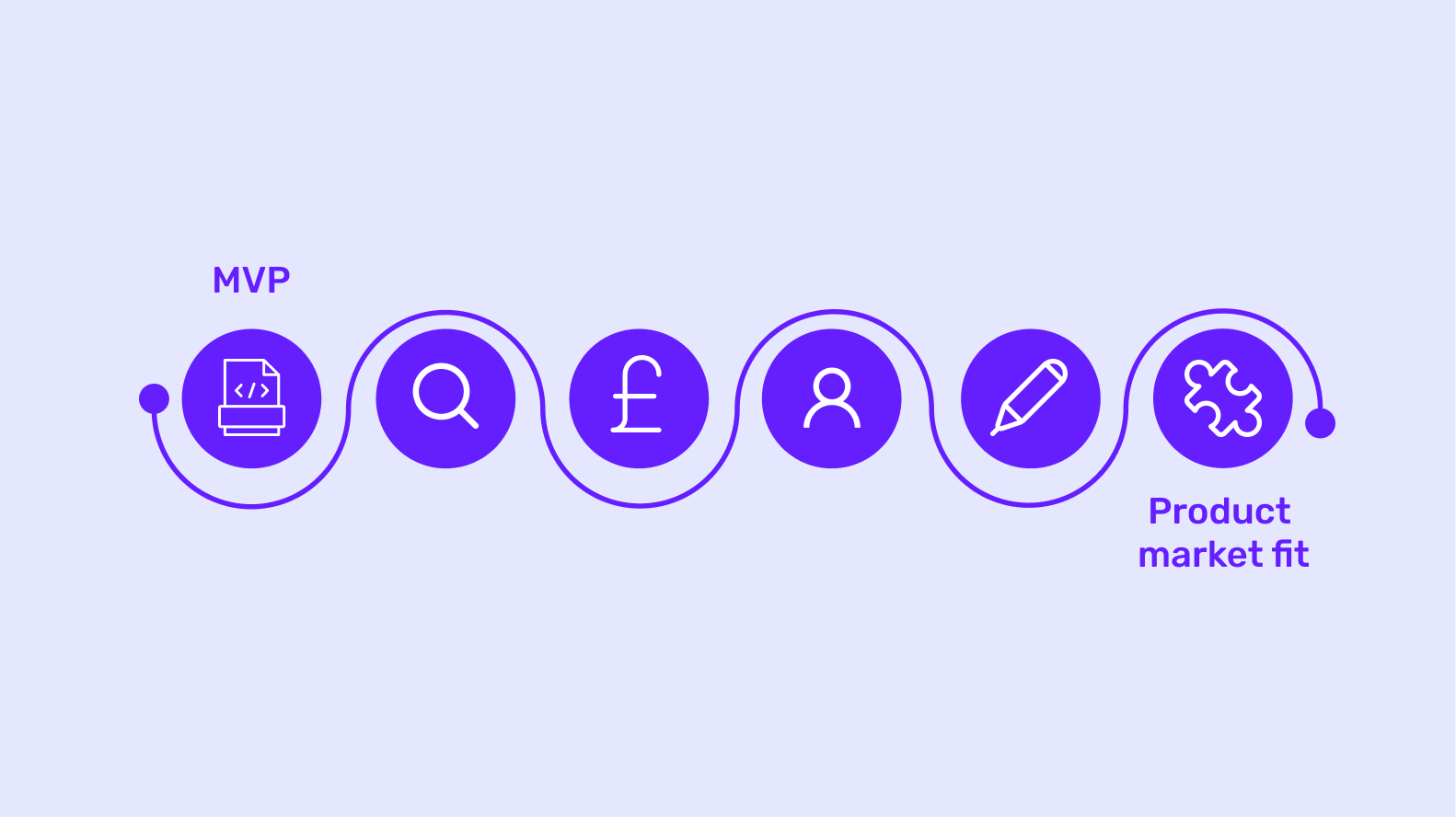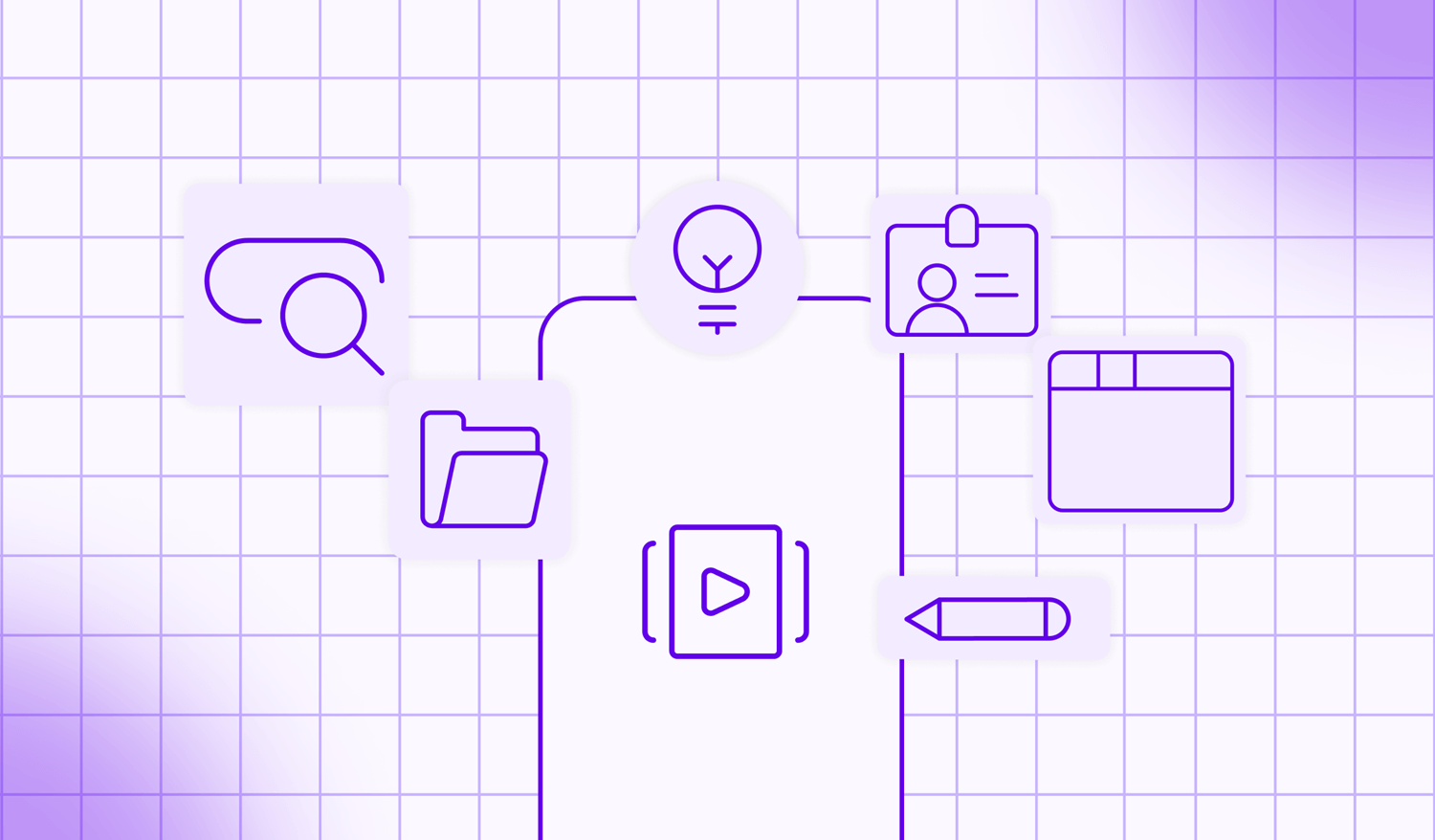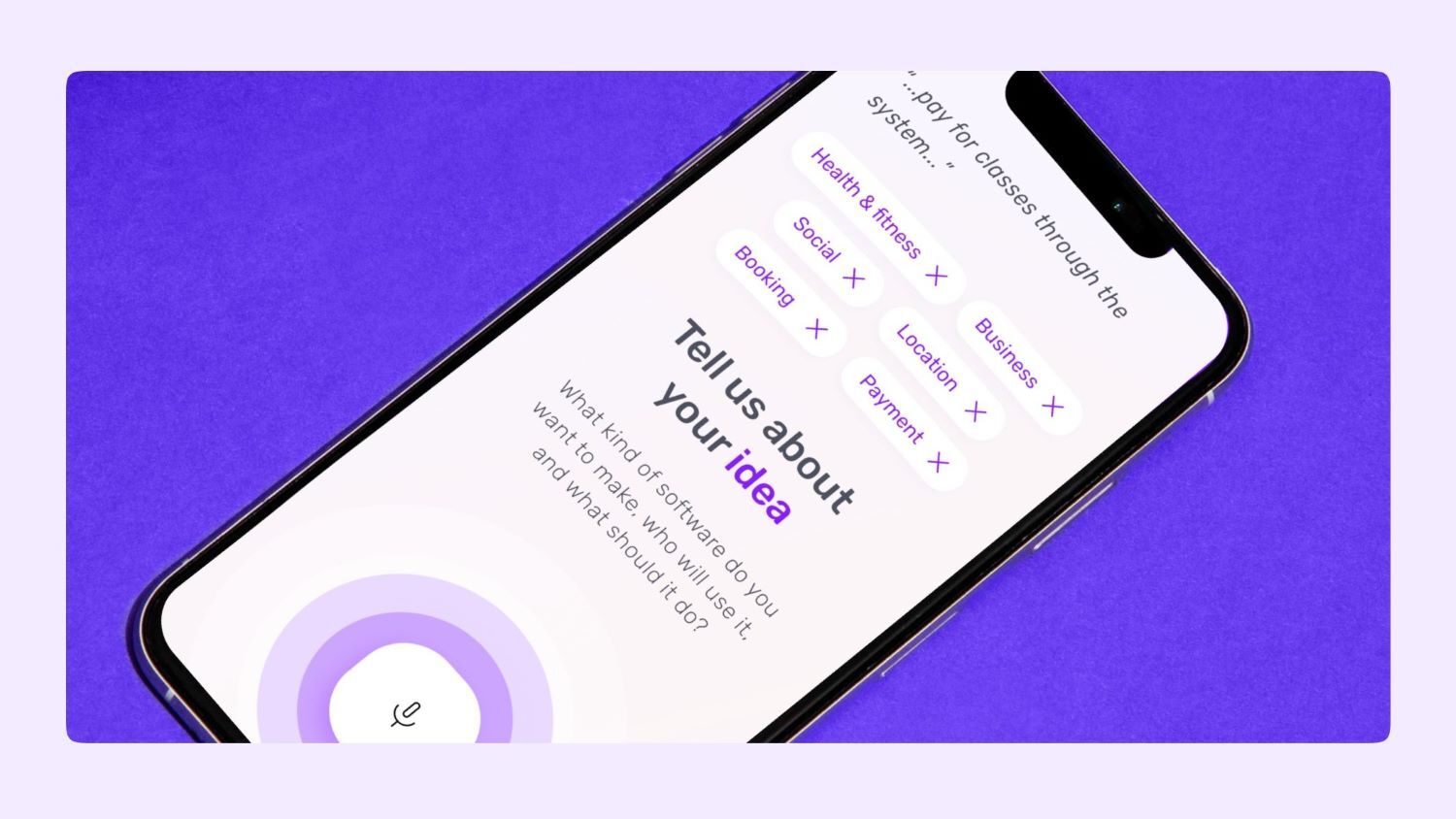Thought the hard work was over after launching your app?
You thought wrong.
Because the period immediately after your app launch is absolutely crucial to establishing your app in the market and building the foundations for long-term success.
This period starts with you gathering user feedback and using it to iterate on your app at lightning speed.
Once you’re over the teething issues, you can scale back the frequency of these feedback loops – but keeping a growth mindset is key.
That’s because the most successful apps are always open to pivoting in order to reach their full potential.
In this blog, I’ll give you a range of frameworks you can use to gather actionable user feedback, while also providing a step-by-step mobile app development roadmap to follow.
Let’s get started👇
Why is a post-launch app development roadmap important?
The app you initially launch on mobile app stores is your Minimum Viable Product (MVP), including essential features to meet user needs. This allows you to test your concept in the market, minimise development costs and gather feedback to inform future development.
And this is exactly why you need a post-launch app development roadmap. This plan helps you find all the information you need to achieve product-market fit and scale your app in the long term.
Aside from this, here are some other key outcomes a post-launch app development roadmap helps you achieve:
1 - Understanding user behaviour
Knowing how users engage with your app is vital. Are they using it as you planned or in unexpected ways?
Think about Facebook's start – initially designed for connecting college students, it turned into a worldwide social network. Users moved beyond just connecting; they shared life moments, built communities and reshaped digital socialisation.
This unexpected evolution showed Facebook's adaptability, underlining that a platform's success often relies on understanding and embracing the evolving needs and behaviours of its users.
2 - Creating new milestones
A post-launch mobile app development roadmap helps you to set milestones for the future development of your app.
Look at Slack for inspiration. Originally crafted as a team communication tool, Slack adapted its milestones by understanding various user groups and their unique needs.It transformed from a basic messaging platform into a collaboration hub, facilitating smooth communication and project management.
Slack's success lies in creating milestones that attract diverse audiences, acknowledging that a universal approach isn't the recipe for sustained growth.
3 - Enabling user-driven growth
After launching your MVP or Minimum Viable Product, you need to embrace change and adapt your core principles. A good post-launch roadmap lets your users take the lead, determining your app’s evolution.
Consider Twitch, which was initially created for gamers to share experiences but later expanded far beyond its original purpose. For example, users diversified content into art, music and lifestyle, steering Twitch to unforeseen heights.
Twitch's success, fueled by adapting to user preferences, positioned it as a pioneer in live streaming. This showcases that embracing change and empowering users to shape the platform's path can result in unexpected success.
11-step post-launch app development roadmap to ensure long-term success [Infographic]
Now, let’s take a look at the process your post-launch mobile app development roadmap should follow to ensure you have all bases covered 👇

5 strategies to help you create your post-launch app development roadmap
In order to keep your roadmap on track over the medium and long term, here's what you need to do 👇
1 - Prepping for post-launch success
Clearly map timelines for evaluation
So you continue to make incremental improvements to your app, you need to establish clear evaluation timelines. The best way to do this?
By creating a post-launch calendar that outlines the frequency of regular reviews.
This structured approach ensures that your app's performance is consistently under the microscope, fostering a culture of continuous improvement.
Let's break it down:
A post-launch calendar might include monthly check-ins during the initial phase, ensuring you keep a close eye on user engagement, feedback and any potential hiccups.
As your app matures, these check-ins could transition to quarterly assessments, allowing for more comprehensive dives into performance metrics and user trends.
For example, say you launched your fitness app in January. Monthly assessments in the first quarter might reveal that users engage more with workout features on weekends.
Armed with this insight, the development team can prioritise weekend-specific content or features. These could include exclusive weekend challenges or push people to share their weekend workout numbers on their social media.
By the end of the second quarter, the app might introduce personalised workout plans based on individual user preferences, identified through ongoing assessments.
Define clear success and failure metrics
These mobile app metrics should be regularly re-assessed to align with the evolving landscape of your app and the dynamic market it inhabits. Some key things to keep an eye on include:
- User engagement- monitor user interactions, active users and session durations to gauge the level of engagement with your app
- Retention rates - assess how well your app retains users over time; high retention indicates a loyal user base and the effectiveness of your app's value proposition
- App responsiveness- evaluate how quickly your app responds to user actions; this slows the responsiveness and can lead to frustration and decreased user satisfaction
- Crash rates- keep an eye on the frequency of app crashes; a low crash rate is crucial for maintaining a seamless user experience
- App load time- measure the time it takes for your app to load; faster load times contribute to a positive user experience and can impact user retention
- Conversion rates- track how well your app converts users towards desired actions, such as making a purchase or subscribing to a service
- User feedback and reviews- pay attention to user reviews and feedback on app stores; this qualitative data provides insights into user satisfaction and areas for improvement
- In-app navigation- analyse user navigation patterns within the app and identify any points where users might drop off or encounter difficulties
- Monetization metrics- if your app involves monetization, you should track revenue, average revenue per user (ARPU) and other financial metrics
- App performance across devices- ensure consistent performance across different devices and operating systems; address any disparities to provide a seamless experience for all users
2 - Staying focused on your vision
Articulate your vision
Defining what your app aims to achieve in the long term and how it fits into the broader ecosystemis the key purpose of your vision.
Say you have a language-learning app. Here, your vision would likely be to create a world where linguistic barriers dissolve by making languages more accessible.
This vision serves as your North Star, influencing every decision and development choice while ensuring that each feature and update contributes to your overarching success.
Implement your vision
To implement your vision, you now need to translate it into tangible strategies that address the changing needs of your users. For your language-learning app, your strategies could include:
- Progressively introducing new language modules
- Incorporating AI-driven personalised learning experiences
- Establishing partnerships with educational institutions.
Identify problems and solutions continuously
As problem-solver-in-chief, you need to know the issues your app deals with and the solutions it offers.This not only guides development but also makes sure your app has a clear purpose.
Returning to the same language-learning app, you need to constantly identify the challenges learners face. These may include lack of engagement or difficulty in retaining information which could be solved by:
- Incorporating gamification elements for engagement
- Deploying AI algorithms for personalised learning paths
3. Analysing feature success and improvement opportunities
Identify successful features
Ensuring the long-term success of your app isn’t just about Whack-A-Mole problem solving. You also need to identify which features add the most value to your audience.
After all, making unnecessary tweaks to them could result in you shooting yourself in the foot.
Say you have a task management app and your data reveals that the "collaborative workspace" feature has very high user engagement.
While there may be marginal gains you can make here, the feature shouldn’t change without thorough consultation with your users.
Plan initiatives for improvement
By the same token, some of your star features might not be shining as bright as you hoped. Thankfully, there’s always a chance for a glow-up.
Take the task management app, for instance. The "notification system" is doing its job, but could be levelled up with more personalisation options.
To ensure you offer your user base exactly what they’re looking for, conduct surveys and make feature updates that cater to their expectations.
4 - Implementing a continuous loop for app improvement
Conduct regular experiments to see what works and what doesn’t
In the early stages after your app launch, regular releases and beta tests will help you gather a ton of information from your users.
If your app is a fitness tracker, you could:
- Release updates with new workout routines
- Test a beta feature that tracks sleep patterns
This helps you to quickly iterate on your app and improve user experience.
Establish standard processes
As your app becomes more established, it’s worth thinking about shifting to quarterly check-ins. For your fitness tracker app, these quarterly checks could mean:
- Diving deep into user surveys to account the latest fitness trends
- Crunching numbers on your most-loved features
While you’ll be making smaller tweaks rather than sweeping changes here, this process ensures your app continuously evolves in line with user needs.
5 - Gathering actionable feedback
Engage in continuous customer dialogue
Speaking to your users on channels like social media and support forums gives you an unfiltered view of the challenges they face.
Beyond developing features that help them solve these problems, you should also think about creating official how-to guides and troubleshooting steps.
As a result, you can build trust with your user base and provide easy fixes to recurring issues.
Focus group feedback
A focus group is a gathering of individuals chosen to provide feedback on a product or service. In this case, it's not just about getting feedback; it's an examination of every nook and cranny in your app.
In a language learning app, for example, you could seek insights on specific language modules, pronunciation features and interactive exercises. This would help to ensure your development is shaped by real-world experiences and needs.
In the language-learning world, your focus group should include users of all proficiency levels. They might praise a gamified module or provide valuable input on how the pronunciation feedback system could be even better.
The result? Detailed feedback guides your app to become more user-friendly and effective, ensuring your app aligns with the needs of your target users.
Design comprehensive surveys
When creating surveys, shape your inquiries to dig deep into user problems.
Let's take a productivity app, for instance. Your survey could ask about the features that users swear by, the hurdles they stumble over and their ideas to improve the user interface.
By making some questions compulsory, you’ll ensure that you get the fullest picture possible before you think about implementing any changes.
Post-launch mobile app development roadmap best practices
Staying curious throughout the development of your app is crucial. Here are three things that ensure you do just that 👇
1 - Avoiding attachment to initial ideas
Remember how Facebook kicked off as a college networking site and then transformed into a social media behemoth?
Your app journey might take unexpected turns too, guided by what your users and the market are telling you. So keep an open mind.
2 - Questioning and testing
Constantly seeking feedback from your user base is the key to the success of your post-launch development roadmap.
Take a cue from Amazon—they introduced one-click buy functionality to improve user experience.
3 - Staying focused on users
Focusing on user-centric development helps to reveal hidden needs and preferences, while also steering you clear of assumptions.
Let’s look into Slack's journey. Born as an internal tool for a gaming company called Tiny Speck, Slack pivoted when the team recognised its broader potential. The shift wasn't a whim; it stemmed from the team's own quest for a superior internal communication platform.
By prioritising user needs, this transformation led Slack into becoming a go-to communication tool. It's a testament to the power of listening to what users truly need.
A cautionary tale: Radioshack vs. Sony
Radioshack's downfall was rooted in areluctance to pivot from its traditional retail model.As the digital age dawned, the company clung to outdated strategies, failing to grasp the significance of the changing tech ecosystem.
The absence of a future-proof significantly contributed to Radioshack's decline, illustrating the perils of remaining steadfast in the face of industry evolution.
In stark contrast,Sony demonstrated a remarkable capacity for reinvention. From its origins as an electronics company, Sony decided its best path forward was to transition to a multimedia conglomerate. The success of PlayStation, the Walkman and their later evolution into a global entertainment powerhouse shows how important pivoting your roadmap can be.
This shows that pivoting isn’t a sign of weakness; it's a necessity to survive and thrive.
In conclusion
When it comes to your post-launch mobile app development roadmap, the only constant is change.
And while you should always stay committed to the fundamentals of your vision, listening to users and keeping an open mind will give your app the best chance of success.
If you've just launched your app and need support to develop your MVP, hit the banner below👇
Want to start your app project with us?
Book a demoSpeak with one of our product experts today.
By proceeding you agree to Builder.ai’s privacy policy and terms and conditions

Entrepreneurial senior management executive of fast growing technology businesses. Successful in taking ideas from concept to profitability, using a blend of lean, agile and rapid result methodologies. A background in building and managing cross-functional and hybrid teams, with a record for retaining talented individuals and delivering results. Skilled in developing and maintaining a clear product and project vision, strategy and roadmap. Willing and able to adapt to changing environments. Often named as a Crisis Manager with a vision to “Make Things Happen”.












 Facebook
Facebook X
X LinkedIn
LinkedIn YouTube
YouTube Instagram
Instagram RSS
RSS


